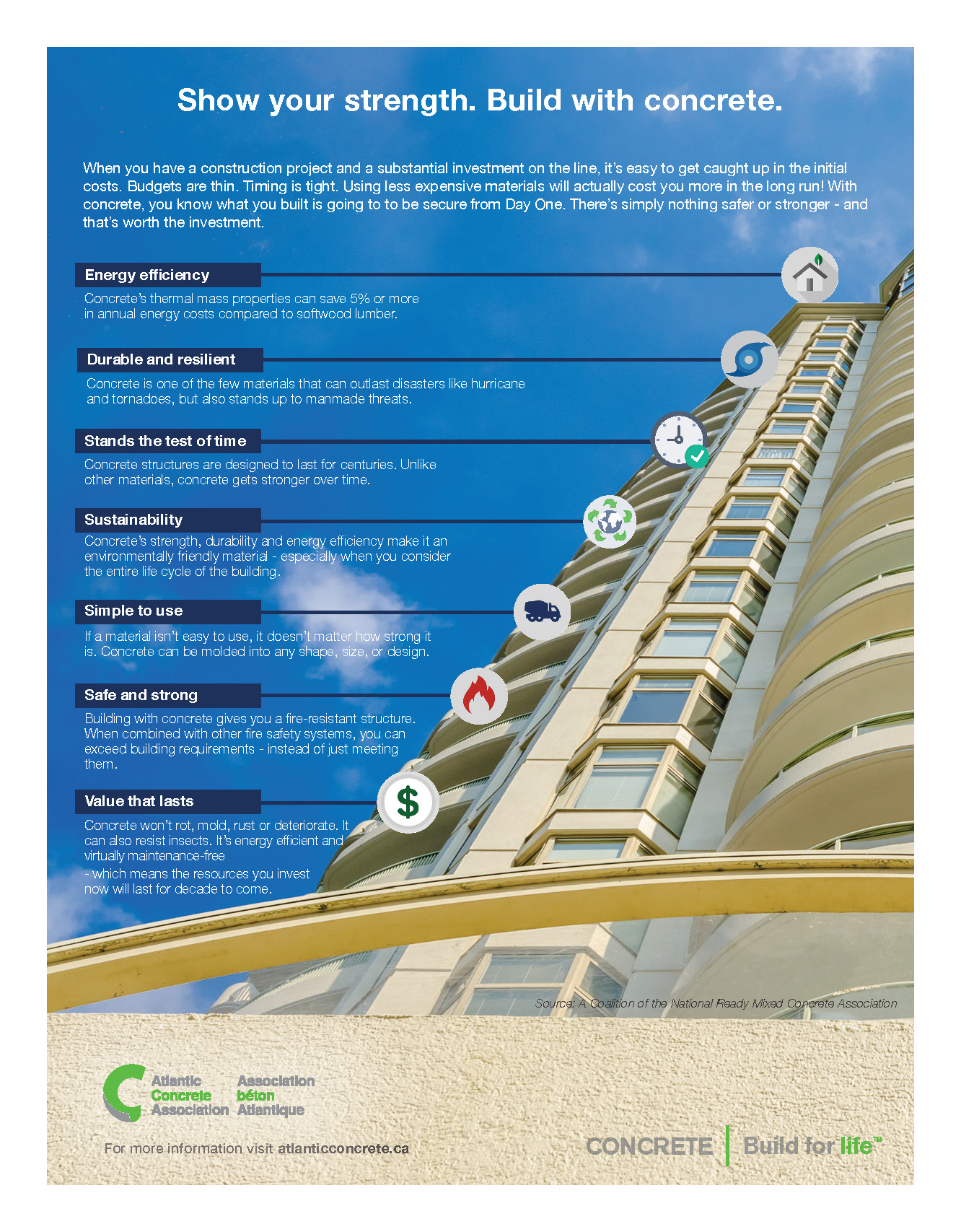Concrete thoughts:
- It takes less energy to produce concrete than it does to produce steel or wood according to a study conducted by the National Ready-Mixed Concrete Association and reported by the World Business Council for Sustainable Development.
- The production of cement – the primary ingredient of concrete – is responsible for 1.5% of Canada’s CO2 emissions, compared with 3% for the forest industry.
- Given the costs and challenges of shipping concrete, most concrete is produced very close to where it will be used. This reduces the need for fuel for transportation.
- Concrete is highly reflective. A high percentage of the light that hits concrete roads and walls is reflected, thereby helping to keep cities cooler and reduce the need for air conditioning.
- Heat moves very slowly through concretewalls and floors, thereby reducing swing in indoor temperatures.
- The industry increasingly uses waste products to the replace some of the conventional cement required in the production of concrete.
- The concrete industry has made important progress in its use of alternative fuels.
- The longevity and stability of concrete means that it requires less maintenance and it is rarely replaced.
For more information on the environmental benefits of concrete, please visit the Rediscovery Concrete website.
Environmental Product Declaration Document for Canadian Ready-Mixed Concrete
LEED® AND ENVIRONMENTAL PRODUCT DECLARATIONS
Since its inception, the LEED® green building program has been used to reduced environmental impacts of the built environment. LEED® has been a market transformation device affecting all sectors of the construction industry, including concrete production and construction.
The system is based on four certification levels (certified, silver, gold and platinum), allowing projects to earn points for environmentally friendly strategies employed during the design and construction process. Because of concrete’s versatility there are many applications where concrete can be used in a building project, from foundation and superstructure to sidewalks and parking lots. That means concrete can contribute to every credit category.
An Environmental Product Declaration (EPD) for building materials can earn your products valuable credits within the LEED® green building program meet a growing number of procurement requirements for governments and industry. Concrete is an important component of these credits. Using concrete can influence 25 of the 55 LEED® V4 credits and prerequisities and potentially contribute to as many as 74 of the 110 points available. Download the EPD document
Detailed information on the LEED® v4 and project certification process is available at www.usgbc.org or www.nrmca.org/sustainability or cagbc.org.
Environmental Product Declaration
Download the EPD document Document for Canadian Ready-Mixed Concrete
THINGS TO CONSIDER WITH CONCRETE
STRONG, DURABLE, AND LOW MAINTENANCE
Concrete products last decades longer than alternative building materials. Not only is concrete’s structural stability maintained for longer periods, it is non-combustible, preventing the spread of fire from one unit or one building to another. It is resistant to moisture and doesn’t rot or mold. And it is sufficiently strong to resist impacts, blasts and natural catastrophes like earthquakes, tornadoes and floods.
ENERGY-EFFICIENT
The ability of concrete products to store energy (their thermal mass) helps moderate interior temperature conditions, allowing a more constant temperature both in cold and hot regions. It improves a building’s “passive survivability” in the event that services such as power, heating fuel, or water are lost — minimizing energy demands for the city as a whole and reducing the GHG emissions from heating and cooling energy.
COMFORTABLE
Concrete products have intrinsic properties of acoustic insulation. This can help amplify sound within a space or dampen it between spaces. Concrete buildings can measurably reduce sound transmission between residential units, giving occupants more privacy.
EMISSION-FREE
An inert substance when cured, concrete is emission-free and will not emit any gas, toxic compounds or volatile organic compounds.
VERSATILE
While strong and functional when hardened, concrete’s plasticity when freshly mixed lets designers adapt it to whatever form, shape, surface and texture they can imagine. Innovations such as ultra-high performance concrete, photocatalytic concrete and pervious concrete are also enabling new and creative uses.
IDEAL FOR ADAPTIVE REUSE
Because of concrete’s strength, sound attenuation, and fire resistance, concrete buildings can easily be converted to other occupancy types during their service life. Reusing buildings in this way can help limit urban sprawl and further contributes to the conservation of our resources and preservation of the environment.
COST-EFFECTIVE
Thanks to their durability, resilience, low maintenance requirements and energy-efficiency, structures built with concrete products reduce operating costs related to operational energy consumption, maintenance, and rebuilding following disasters. Insurance costs for concrete buildings during the construction and operating phases have also been shown to be significantly lower than for buildings constructed with combustible, moisture-sensitive materials.
100% RECYCLABLE
Concrete products can be recycled as aggregate — for use as sub-base material in roadbeds and parking lots, for gabion walls, as riprap to protect shorelines or in other applications — or as granular material, thereby reducing the amount of material that is landfilled and the need for virgin materials in new construction.
PRODUCED LOCALLY
Concrete is typically manufactured within 160 kilometers of a project site, using local resources. This greatly minimizes shipping and pollution and makes a significant contribution to the local economy.




